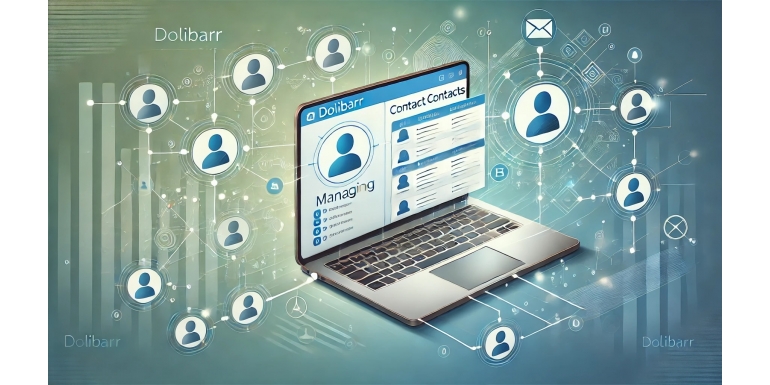
Managing contacts is a crucial part of any Customer Relationship Management (CRM) strategy. In Dolibarr, an open-source ERP/CRM, you can effectively structure contact databases to ensure optimal organization. However, specific scenarios, such as managing multiple contacts sharing the same email address, can present unique challenges.
This article delves into the tools, solutions, and best practices for managing multiple contacts with the same email address in Dolibarr. We’ll explore the available features, required configurations, and concrete examples to help you maximize this powerful tool.
1. Why Managing Multiple Contacts with the Same Email Address Matters
a) Common Scenarios
In some industries or professional contexts, it is common for several individuals to use the same email address, for instance:
- Small family businesses: The same email may be used by different team members.
- Associations or NGOs: A generic address like
contact@organization.orgmay be shared among several members. - Large clients: Workgroups or specific departments may use a single email address to centralize communications.
b) Associated Challenges
- Confusion in records: The same email linked to multiple contacts can lead to errors or duplicates.
- Inefficient tracking: Identifying the correct person among associated contacts can be challenging.
- Technical limitations: Some CRMs do not allow multiple contacts to share one email address, complicating management.
2. Dolibarr’s Native Features for Contact Management
Dolibarr provides tools and modules designed to address various contact management needs.
a) Creating and Organizing Contacts
- Multiple contacts: Dolibarr allows multiple contacts to be created under the same entity, whether it’s a client, supplier, or third party.
- Customizable fields: You can add specific fields to differentiate contacts sharing an email address.
b) Assigning Roles
Each contact can be assigned a specific role, such as:
- Purchasing manager.
- Communications officer.
- Primary point of contact.
These roles help quickly identify the appropriate person to contact.
c) Using Tags and Notes
Dolibarr enables you to add tags and notes to contacts to provide contextual information. For example, you can note: "This contact handles orders for Department A."
3. Configuring Dolibarr to Manage Multiple Contacts with the Same Email
Dolibarr can be configured to address specific needs related to managing multiple contacts.
a) Activating Necessary Modules
To maximize contact management capabilities:
- Go to the Modules/Applications section.
- Activate the following modules:
- Third Parties and Contacts.
- Tags (for classification).
- Notes and History (to track interactions).
b) Creating Contacts Under the Same Entity
- Go to the relevant entity (client, supplier, etc.).
- Add multiple contacts using the Create a New Contact option.
- Fill in roles, phone numbers, or any other relevant fields to differentiate the contacts.
c) Using Custom Fields
- Navigate to Setup > Custom Fields.
- Add fields like "Responsibility Area" or "Department" to better organize contacts.
d) Resolving Email Conflicts
If Dolibarr detects a conflict due to a shared email address:
- Option 1: Add a tag or note to clarify the contact’s identity.
- Option 2: Include a unique identifier, like a number or nickname, to differentiate records.
4. Additional Modules to Enhance Contact Management
Dolibarr can be expanded with modules available on Dolistore to improve the management of multiple contacts.
a) Advanced CRM Module
- Adds advanced interaction tracking features for each contact.
- Enables filtering contacts by role, department, or tags.
b) Merge and Cleanup Module
- Identifies and merges duplicates, even for contacts sharing the same email address.
- Simplifies the data update process.
c) Synchronization with External Tools
Synchronization modules allow Dolibarr to connect with tools like Gmail, Outlook, or Mailchimp while efficiently managing multiple contacts.
5. Best Practices for Optimized Contact Management
To ensure smooth management and avoid errors, adopt these best practices:
a) Centralize Information
Add all contacts sharing an email address under the same third party (client or supplier) to avoid duplicates.
b) Maintain a Clean Database
- Regularly delete outdated contacts.
- Merge identified duplicates using built-in tools or additional modules.
c) Train Your Team
Educate your teams on the importance of roles, tags, and notes for effective management of multiple contacts.
d) Automate Notifications
Set up Dolibarr to send automatic notifications to the relevant team when a specific contact interacts via a shared email address.
6. Case Studies: Resolving Business Challenges
a) Case Study 1: An NGO with a Generic Email Address
An NGO uses a generic email address for all office members. With Dolibarr, each member is added as a distinct contact with clear roles (Treasurer, Events Manager, etc.). Result: Improved task organization.
b) Case Study 2: A Retail Business
A key supplier uses a single email address for its sales team. By assigning specific roles to each contact and using tags, the retail business’s sales team can quickly identify the right person to contact in each situation.
7. Future Improvements in Dolibarr
Dolibarr continues to evolve to meet modern business needs. Future enhancements may include:
- Advanced Duplicate Management: Automatic detection of conflicts involving shared email addresses.
- Improved Workflows: Integration of automation for specific scenarios involving multiple contacts.
- Custom Dashboards: Real-time tracking of interactions by contact or group.
Conclusion
Managing multiple contacts sharing the same email address may seem complex, but with the right tools and configurations, Dolibarr makes this process significantly easier. By leveraging its native features, additional modules, and best practices, you can create an organized, efficient database tailored to your business needs.
Whether you are a small business, an NGO, or a complex organization, Dolibarr offers the flexibility and solutions necessary for optimized contact management. Take the steps today to enhance your CRM system and ensure a better client and operational experience!
